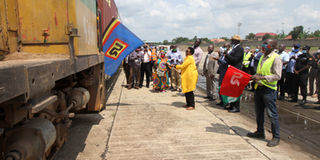Two years after RVR: Uganda railways makes first shipment

Transport state minister Kabatsi flags off the consignment, the first since Uganda Railways took back operations of the railway network. PHOTO | CHRISTINE KASEMIIRE
Uganda Railways Corporation (URC) has dispatched its first export shipment two years after government threw out Rift Valley Railways.
The shipment, flagged off by Transport state minister Joy Kabatsi in Mukono at the weekend, included 28 containers and 14 wagons to Mombasa through the metre gauge railway.
“The consignment is 784 tonnes and it is going to Mombasa on its way to Europe,” Ms Kabatsi said, noting that export by rail will cut costs and increase savings for Ugandan exporters to reinvest.
In 2018, government returned the operations of the metre gauge railway to Uganda Railways Corporation, after terminating a concession in which Rift Valley Railways had been managing the network from 2006 to 2030.
In a meeting prior to the cancelation of the concession, the Ministry of Finance had resolved that government ends all ongoing discussions to salvage the concession on grounds that RVR had failed on all conditional demands.
The operations were subsequently returned to Uganda Railways Corporation.
Mr James Mugisha, the Africano Green Impex export manager, said shipping goods through the railway system will go a long way in saving the company the cost of transport.
“The minimum cost per container of 20ft is around $1,500 (Shs5.5m) but by rail, it is $600 so you have around $900(Shs3.3m) to save per container,” he said.
Mr Bharath Redity, the Bakhresa Grain Milling general manager, said the railway system is currently a critical part of transport given that Covid-19 has seen the cost of road transport increase.
However, challenges of travel time are still a concern, especially to exporters.
While a car spends between three and four days on the road from Mombasa, a train could take up to six days.
Thus, Mr Redity urged government to rehabilitate the railway network as well as extending lines to heavy duty manufacturers to ease transport.
Uganda has accelerated plans to reinforce the railway stem as an alternative to road transport in a bid to mitigate the cost of transport.
Mr Charles Kateeba, the URC managing director, said that whereas bottlenecks such as lack of reliable locomotives have been a challenge in recruiting exporters, government will continue to invest in the network to improve efficiency.
URC, he said, will spend €29m (Shs126b) on the first phase, which will include rehabilitation of the track from Kyetume to Kampala and between Tororo to Malaba as well as invest Shs48b to purchase two new reachstackers; machines used for lifting containers and four heavy hail locomotives with the capacity to carry between 30 and 35 wagons.
Passenger services
Uganda Railways, according to Mr Kateeba is expected to resume passenger services in September after streamlining operations.
“We are working on improving our facilities in order to meet Covid-19 standards of operation. We may be able to start in the coming month,” he revealed.
URC suspended passenger travel in March after President Museveni announced a ban on public transport.




